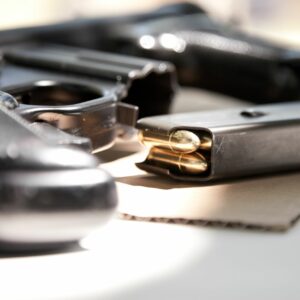Removing Rust From a Gun? Learn Why Some Guns & Parts Are More Prone and How to Prevent It

Removing Rust From a Gun? Learn Why Some Guns & Parts Are More Prone and How to Prevent It
If you’re in the midst of the unpleasant task of removing rust from a gun, you may be wondering what was it that made your gun – or a specific gun part – particularly vulnerable to corrosion.
About one-third of American adults own at least one firearm – with 7.5 million people becoming newly-minted gun owners between 2019 and 2021. Americans purchased almost 60 million guns between 2020 and 2022, according to a report by The Hill. But having a gun and taking good care of it are two different things.
Although pretty much anything made of metal has the potential to corrode, certain types of metal that may be more vulnerable. The metal your gun is made of will have some impact on the rust risk. Other factors that come into play are:
- The design/function of certain components.
- Environmental exposures.
- How well you clean and dry it.
- The conditions in which you store your firearm.
Careful use, regular cleaning, and dry storage of your firearm with vapor corrosion inhibitors (VCI) are essential – at least if you want to avoid removing rust from a gun as a recurrent task.
Why Care About Firearm Corrosion Risk
Preventing firearm rust should be more than an afterthought for all gun owners. While modern firearms do tend to be less vulnerable to rust risk than older models (especially antiques), the potential is always there. And seeing enough DIY articles on removing rust from a gun may convince some that cleaning it off won’t be much trouble. But beyond the time and elbow grease needed to do so effectively, the more times your gun rusts, the shorter its lifespan will be.
Plus, internally corroded elements may not be visible, but are all the more insidious for that – potentially causing a functional failure the moment you need it most.
Rust on a firearm compromises the performance, reliability, and integrity of the piece.
A few examples of the risks you run with gun rust:
- Weakened barrel. Pitting and corrosion inside the barrel can cause the kinds of imperfections that could disrupt the smooth travel of the bullet. In cases of severe pitting, barrel failures can cause explosions – putting not only the shooter but bystanders at risk of injury.
- Bolt and receiver damage. These components are key to safe operation of a firearm – and they can become eroded by rust. The receiver is probably one of the first places you’ll actually see rust damage on a gun. But the damage might be worse than what’s immediately visible. Rust can potentially cause these pieces to crack or break under stress when firing, which would be incredibly dangerous.
- Magazine malfunctions. Magazines get a lot of direct handling. If they aren’t carefully cleaned, the residue left behind can make them more susceptible to rust. If the corrosion is bad enough, it can lead to feeding issues and malfunctions.
- Reduced accuracy due to rusted iron sights, optical mounts, or rifling. If these parts become corroded, your ability for accurate aim may be markedly reduced.
- Unreliable triggers and internal mechanisms. Internal mechanisms of the firearm, including the trigger assembly, could become rusted without you ever knowing it. If this happens, the reliability and safety of the firearm can be directly affected.
 Guns Most Vulnerable to Rust
Guns Most Vulnerable to Rust
The most common type of corrosion that occurs with guns is rust, which is the result of iron or iron alloy components coming into contact with oxygen and moisture (water, humidity, etc.). Abrasive elements like salt or dirt can accelerate the process. Firearm corrosion can also occur if dissimilar metals are stored in close proximity, a chemical reaction known as galvanic corrosion.
Many guns are made with steel components (particularly barrels, receivers, and internal parts) because it is capable of with standing high heat and pressure. But steel is also an iron alloy, and therefore can rust.
That said, the types of guns that may be especially prone to rust risk include:
- Shotguns. A big part of the reason for the rust risk here is that they’re often used in outdoor settings – exposing them to heavy moisture and varying weather conditions. Waterfowl hunters, for example, commonly use shotguns.
- Rifles. Here again, these are popular for outdoor sports/hunting. Exposure to rain, snow, humidity, and direct contact with water (splashing, etc.) can contribute to rifle rust. Also, blued steel finishes are popular with rifles, and the blueing process typically doesn’t offer as much protection compared to polymer coatings that are more popular with handguns.
- Antiques and vintage firearms. Older firearms tend to be made with materials that are far less rust resistant than today’s guns. They lack protective coatings and they may have more iron components that makes the odds of oxidation much higher.
Preventing Gun Rust > Removing Rust From a Gun
Prevention will always be preferable to damage control when it comes to rust and corrosion. Fortunately, Zerust has numerous firearm storage options to make it easier.
Our vapor corrosion inhibitors for firearms include:
- VCI firearm protection bags
- Multipurpose VCI poly bags
- Rust prevention vapor capsules
- Tube & barrel strip
- VCI Fleece-Lined firearm storage bag
We also have gun cleaner & gun oil.
These gun storage solutions can last for years, and are easy to incorporate into your regular gun cleaning & storage routine.
Contact Zerust at 1-866-2-ZERUST (937878) or via our online Contact Us form.
Additional Resources:
5 Firearm Finishes: What’s the Difference? Feb. 25, 2021, By B. Gil Horman, NRA Women
More Blog Entries:
Corrosion Solutions for Firearm Storage Lockers Lacking Built-In Rust Prevention, April 26, 2024, Preventing Gun Rust Blog

 Guns Most Vulnerable to Rust
Guns Most Vulnerable to Rust


